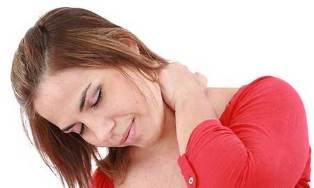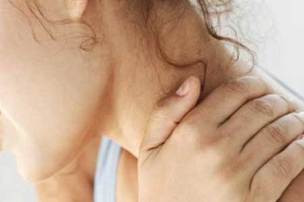In the world there are only a few diseases, which belongs to the man just because he – man. For example, the defeat of the blood vessels and the deposition on their walls of cholesterol occurs in the animal kingdom. Symptoms of degenerative disc disease of the neck may be confused with symptoms of other diseases. Increase in blood pressure is common to all warm-blooded animals. A bad diet can lead to exhaustion and lack of protein and vitamins and chicken, and an elephant and clams, and a supporter of the free style. But osteochondrosis of the spine belongs to the disease, which can boast only one: even with his closest relatives – the primates, the disease is almost absent. After all, in the speeches of the symptoms and treatment of degenerative disc disease of the cervical spine.

Cervical osteochondrosis, then it is?
Osteochondrosis of the cervical spine — diseases of bone and cartilage, which relate to the dystrophic — degenerative. In the basis lies dystrophy (a disorder of the nutrition of the cartilage), and then – its destruction or degeneration. In fact, in osteochondrosis is in the first place suffer from the cartilage of the intervertebral disc, and then "snowball" is complemented by the reactions of bone tissue (osteophytes), the onset of the protrusion and the keel, root symptoms, the emergence of instability in the cervical region, as well as strong headaches and chronic muscle spasm of the deep cervical muscles with impaired regional blood circulation. The reason for the occurrence of degenerative disc disease the intervertebral discs in the cervical or neck – maternity ward just one: is it historically formed the upright position of man. Even in cats, even in cows or hippos is no such constant axial load on the vertically placed back, the spine is in a relaxed, "sagging" state, and the intervertebral disc feels comfortable. In humans as to the development of cervical degenerative disc disease predispose to the following factors:
- Frequent engagement in the upright position;
- Injuries and sudden movements, strikes the head, e.g., low ceilings;
- Carrying loads on the shoulders, in some countries – on the head;
- The lack of active movement. This leads to a weakening of the muscular corset, which is of fundamental importance in the cervical region of the spine.
Also other factors can be attributed to wear in winter, heavy collars and fur caps, with the aim "to serve the fashion", with the epidemic spreading to the reduced consumption of fluids, in consequence of which arises the initial dehydration of the cartilage. This increases the fragility of the discs and causing "pumping them" (narrowing of the thickness), which reduces the elastic pools of properties. In his youth, to the osteochondrosis can lead to a violation of posture in the performance of written tasks and the work behind the computer. Congenital changes of the spine, for example, scoliotic deformity in the infant department. It must be remembered that the above are departments of the spine, the stronger is the stimulus, which can have a negative effect, similar to a "whiplash" injury. So standing or violation of compensatory mechanisms, the protection of our skull from excessive vibration, also leads to osteochondrosis of the cervical spine. Here are the following reasons:

- Flat feet, both longitudinal and cross. The arch, without depreciation, unable to keep the intervertebral discs of the cervical turmoil and destruction;
- Basic osteochondrosis of the lumbar spine. If the flexibility of the lower back, is broken, is it worth it to wait for a good protection against whiplash.
Symptoms of degenerative disc disease of the cervical spine
Symptoms of degenerative disc disease of the cervical spine are extremely varied, but all of them can be summed up on the local and remote manifestations. Local symptoms of cervical degenerative disc disease include:
- Drag and gnawing pain in the muscles, low intensity, had taken root after a long session, e.g. when working in the office and for your computer;
- Crunching when moving the neck. Most significantly reflected in the implementation of morning exercises, in that case, if you plug your fingers in your ears. Then the bone conduction sound exceeds the air, and when turning the neck crunch is heard well. This symptom is indicative of the occurrence of osteophytes, which violate the congruence (accuracy of shape) cartilage and vertebrae;
- Pain in the neck, as when driving (especially sudden). These pains are called Servicio, similar to the "shot" in the lower back, which is called lumbago. Such a pain already belongs to the root manifestations of degenerative disc disease. Arise when the sharp concussion of the nerves, which occurs when laughing, coughing, sneezing, straining. This pain similar to neuralgia, and is similar to the punch of the electric current on its power and surprise. The most commonly occurs in the thoracic region of the spine;
Remotely featured include:
- Headaches during osteochondrosis. Arise subtly, reminiscent of the "helmet" or "helmet", often appear symmetrical. The intensity is low, may be associated with the movement, but optional. Often "migrate" to the head from the neck, and accompany a sedentary lifestyle.
- The conductor of the disorders of sensitivity. Often appear in night – waking, the person feels that he has numb fingers on my hands. Most often it is the little fingers and half the nameless finger, on the side of the little finger. To improve sensitivity, it is necessary to move the hands, neck and change of posture.
This happens due to the retention of the roots of the cervical plexus in the places of output of nerves. It is important that the roots of prejudice from the the greater part of the spasserovannye the muscles of the neck, which prilezhat to the vertebrae. Cervical osteochondrosis, the symptoms of which we have solved, can complicate the instability of the cervical spine. In this case the height of all intervertebral discs in the cervical region will be uniformly reduced, and the neck acquires a "pathological mobility", or a tendency to develop pain and a variety of deformations while driving. When this condition arises the frequent occurrence of retention roots of the nerves and increases the risk of protrusion and hernia.

The Role of muscle cramps
There is a secondary muscle spasm, which is called myofascial — tonic syndrome. This condition can appear in different parts of the spine, everywhere there, where are the striated muscles. Due to the reduction of the height of the intervertebral disc and outgrowths of marginal osteophytes, the muscles "catch up", and their vascularity is getting worse. Respectively, and decreases the venous outflow. Such a situation leads to edema of the muscles and their chronic spasm, which is manifested by pain and stiffness in the neck and back.
Diagnosis of osteochondrosis of the cervical
In typical cases of osteochondrosis of the cervical spine flows from the above-described symptoms. Therefore, it is the main phase of the diagnosis was, and remains, the identification of the patient's complaints, determining the presence of collateral muscle spasms, using a simple palpation of the muscles along the spinal column. To confirm the diagnosis of degenerative disc disease is possible by means of x-ray studies:
- "X-ray" of the cervical spine, even with the functional samples on the flexion – extension shows cartilage, because of their tissue transmits x-rays.
Regardless of the position of the vertebrae possible to make general conclusions about the height of the intervertebral disc, apply a straightening of the physiological curvature of the neck – lordosis, as well as on the availability of peripheral growths on the vertebrae during prolonged irritation of their surfaces fragile and dehydrated intervertebral discs. Functional tests allow to confirm the diagnosis of instability of the cervical spine;
- Magnetic and x-ray, computed tomography shows for the refinement of the internal structure of the cartilage and the education of the protrusion and hernia.
So the exact diagnosis, complications of disease, and the outcome of the tomography is an indication of the operative treatment of hernia in the department of neurosurgery.
Treatment of cervical degenerative disc disease, drugs
Treatment of degenerative disc disease of the cervical spine was always complex: first, it removes the acute pain with the help of drugs, then, when the cervical osteochondrosis (pain shrinking) until they return, join the physiotherapy and massage techniques, and after cupping this deterioration begins the phase of secondary prevention, that my task puts the avoidance of repeated exacerbations. Sometimes the patient is prescribed spa treatment. The main groups of drugs for the relief of acute pain are:
- Non-steroidal anti-inflammatory drugs. Cropped inflammatory component;
- Muscle relaxers of the central action . Reduce the tone of the spasm of the muscles, reduce pain, muscle stiffness;
- B vitamins – contribute to the improvement of the trophic nervous tissue;
- Drugs to improve the microcirculation of capillary blood — they improve the outflow of and normalize the function of muscles.
These funds are assigned or orally or intramuscularly, for greater efficiency. The goal is the elimination of acute pain syndrome. Then, later 2-3 days pass at the reception of tablets, actively applying ointments or gels, which are rubbed on the neck and back. In the second phase of the connect rehabilitation methods – electrophoresis with vitamins and hydrocortisone, massage, diving traction, and a massage shower, iglorefleksoterapevta techniques. Sometimes prescribe medicines – chondroprotectors, but when taking them inside their efficacy has not been demonstrated. Only intra-articular introduction the replacement of joint fluid, helps reduce crusty, ease of movement and remove the pain. But when osteochondrosis this technique, he has worked on major joints, almost does not apply. The operational treatment is carried out in a more pronounced compression of the protrusion, or hernia of the sensitive or motor root. The indication for surgery are refractory expressed pain during the month, intractable treatment, or the progression of weakness in the muscles of the hands, extending the zone of reduction of sensitivity, and also confirmation of the diagnosis of protrusion and hernia using MRI or CT.
Gymnastics at cervical osteochondrosis
Gymnastics in osteochondrosis of the cervical spine – it is nothing like the rational adherence to physical activity and maintaining a healthy lifestyle: you degenerative disc disease occurs in all without exception of people, from the children's age, and even something where it is considered to be the "choice of standards". Because there is no man, who is especially in adult life should the symptoms of degenerative disc disease, then it is the task of the exercise is to leave only the objective, the radiological signs of the disease, and remove all complaints. It is known that even the elders and the old man can not complaint on his neck and back, but just in case, if you devote enough time prevention.
Prevention of cervical degenerative disc disease
Maybe an example of degenerative disc disease can be inferred are the principles of prevention, which are shown to all and sundry, and in result, we get rules of a healthy lifestyle. Here they are:

- Free movement, without unnecessary weights, exercise without load, only with the weight of your own body;
- Drinking large amount of clean water, because with age there is the dehydration of the cartilage;
- The preservation or normalization of body weight;
- The profession of such types of loads, which reduces the load on the back (swimming);
- Refusal of bad habits;
- Alternation of mental load with physical. Every hour and a half in the mental work it is recommended to change the type of activity on the physical work;
- Prevention of hypothermia of the neck, back and lower back, and especially in the spring – autumn period of the year.
Only when adhering to these simple recommendations, osteochondrosis of the cervical spine, symptoms, treatment and which we detailed break down, won't you bother coming years.































